26th August, 2025
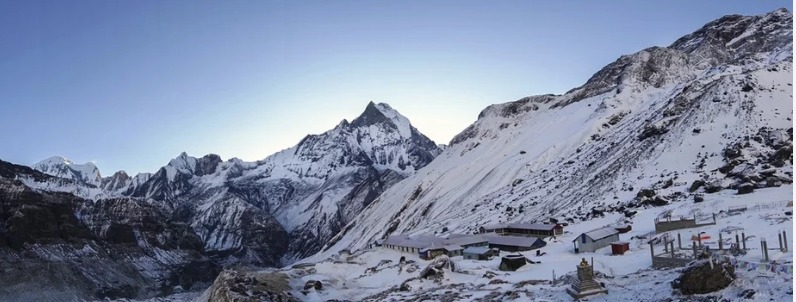
Sep 03, 2023
Annapurna Base Camp Trek In October
- Benefits of Trekking in October
- Overview of Annapurna Sanctuary and Base Camp
- Route Options and Itinerary Planning
- Weather and Climate Conditions
- Preparation and Packing Guide
- Fitness and Training Tips
- Permits and Regulations
- Accommodation Options Along the Trail
- Food and Dining Experiences
- Cultural Insights and Local Customs
- Photography Tips for Capturing the Trek
- Safety Tips and Considerations
- Altitude Sickness: Symptoms and Prevention
- Flora and Fauna Along the Trail
- Famous Landmarks and Viewpoints
- Community and Village Encounters
- Equipment and Gear Reviews
- Budgeting and Cost Breakdown
- Transportation to and from Pokhara
- Side Trips and Alternative Routes
- Best Tour Operators and Guides
- Conclusion
- Annapurna Base Camp Trekking packages
Trekking to Annapurna Base Camp in October offers a picturesque adventure amidst favorable weather conditions, making it one of the best times to explore this iconic Himalayan destination. October marks the onset of the dry season in Nepal, following the monsoon rains, ensuring clear skies, mild temperatures, and stunning views of the surrounding peaks.
The trek begins from the lakeside city of Pokhara, where trekkers embark on a journey through diverse landscapes, from terraced hillsides adorned with autumnal hues to lush rhododendron forests ablaze with colors. The route passes through traditional villages inhabited by Gurung and Magar communities, known for their warm hospitality and cultural richness.

GHOREPANI POON HILL ABC TREK
This is a classic trek, visiting Ghorepani (2874m), Poon Hill (3210m) & Annapurna Base Camp (4130m) - all within the Annapurna Conservation Area.Annapurna is a Sanskrit name which literally means...
As trekkers ascend towards Annapurna Base Camp (ABC), located at an altitude of approximately 4,130 meters (13,550 feet), the scenery transitions to alpine meadows and glacial moraines. Highlights along the way include panoramic views of Annapurna I (8,091 meters), Machapuchare (6,993 meters), and other towering peaks that form a natural amphitheater around the sanctuary.
October offers pleasant trekking conditions with daytime temperatures ranging from 10°C to 20°C (50°F to 68°F) at lower elevations, gradually decreasing as you ascend higher. Evenings can be cool, especially at ABC where temperatures drop below freezing, requiring warm clothing and a good sleeping bag.
Cultural encounters enrich the trekking experience, with opportunities to visit monasteries, observe local festivals, and learn about traditional farming practices. Teahouses along the trail provide basic accommodation and hearty meals, offering a chance to connect with fellow trekkers and share stories of the journey.
Overall, trekking to Annapurna Base Camp in October promises unforgettable scenery, cultural immersion, and a sense of achievement upon reaching the base camp, making it a prime time to experience the natural beauty and cultural heritage of Nepal's Himalayas.
Benefits of Trekking in October
Trekking to Annapurna Base Camp in October offers a host of advantages, making it a favored month for outdoor enthusiasts. As the monsoon season ends in September, October brings clear skies and crisp air to the Himalayas, providing trekkers with stunning panoramic views of the surrounding peaks. The weather is generally stable, with mild daytime temperatures ranging from 10°C to 20°C (50°F to 68°F) at lower altitudes, ideal for comfortable trekking conditions without the heat of summer or the cold of winter.
October also boasts vibrant landscapes adorned with autumnal colors, especially noticeable in the forests of rhododendron and oak trees along the trekking route. The trails are less muddy compared to the monsoon season, enhancing the trekking experience and making it easier to navigate.
Moreover, October falls within Nepal's peak trekking season, ensuring that teahouses and lodges along the trail are fully operational, offering a wide range of accommodation and dining options. This popularity also means that fellow trekkers from around the world converge on the route, providing opportunities for camaraderie and shared experiences.
Overall, trekking in October combines favorable weather conditions, stunning natural beauty, and a vibrant trekking atmosphere, making it an optimal time to embark on the adventure to Annapurna Base Camp.

ANNAPURNA BASE CAMP TREK
The Annapurna Base Camp (ABC) Trek via Ghorepani Poon Hill Trek offers a truly unforgettable Himalayan adventure, combining stunning panoramic views with the rich cultural tapestry of the region. This...
Overview of Annapurna Sanctuary and Base Camp
Nestled amidst the majestic Annapurna range in Nepal, the Annapurna Sanctuary and Base Camp are renowned for their awe-inspiring natural beauty and trekking opportunities. The sanctuary is a glacial basin surrounded by towering peaks, including Annapurna I (8,091 meters) and Machapuchare (6,993 meters), creating a natural amphitheater of snow-capped mountains.
Annapurna Base Camp (ABC), situated at an altitude of approximately 4,130 meters (13,550 feet), serves as the ultimate destination for trekkers seeking to immerse themselves in the heart of the Himalayas. The journey to ABC takes trekkers through diverse landscapes, from terraced hillsides and lush forests to alpine meadows dotted with Himalayan flora.
The sanctuary is also rich in biodiversity, with opportunities to spot native wildlife such as Himalayan thars, langur monkeys, and a variety of bird species along the trail. Cultural encounters with Gurung and Magar communities add a cultural dimension to the trek, offering insights into traditional village life and local customs.
Trekking to Annapurna Base Camp in October allows trekkers to experience the sanctuary's tranquil beauty amidst favorable weather conditions, making it a memorable adventure in the heart of Nepal's Himalayas.
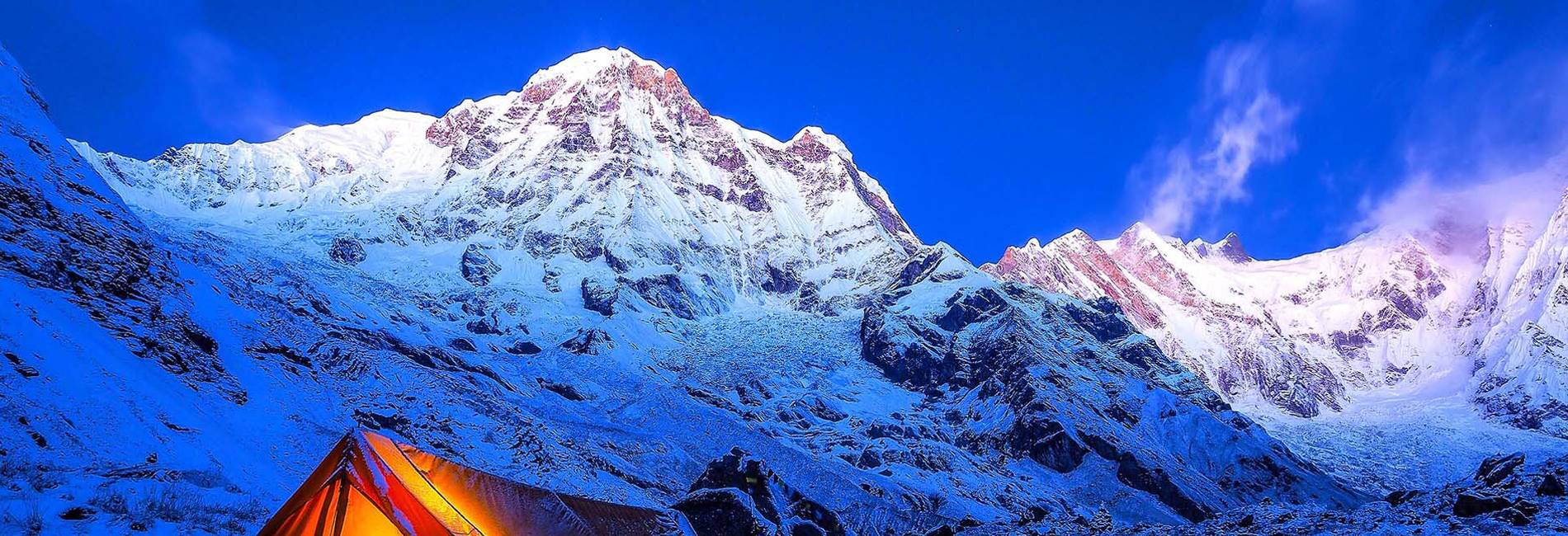
13 DAYS ANNAPURNA BASE CAMP TREK
Discover why “The Annapurna Base Camp (ABC) trek is world-famous. Here is a sample of soaring snow-capped peaks you will see along the trail: Mt. Dhaulagiri (8167m), Mt. Annapurna I (8091m) Mt. M...
Route Options and Itinerary Planning
Planning a trek to Annapurna Base Camp involves selecting the right route and crafting an itinerary that suits your preferences and fitness level. Several route options cater to different trekking durations and experiences:
- Classic Route via Ghorepani: This popular route typically takes around 10-12 days and includes stops at villages like Tikhedhunga, Ghorepani (famous for Poon Hill sunrise views), Tadapani, Chhomrong, and Machapuchare Base Camp before reaching Annapurna Base Camp.
- Direct Route via Bamboo: A more direct approach that skips Poon Hill, ideal for trekkers looking to reach ABC in about 7-9 days. This route passes through villages like Chhomrong, Bamboo, Deurali, and eventually ABC.
- Variations and Side Trips: Depending on time and interest, side trips like visiting hot springs at Jhinu Danda or exploring the Mardi Himal trek route can be incorporated into the itinerary.
When planning, consider factors such as acclimatization days, trekking distances per day, and the availability of accommodation along the route. It's advisable to have a flexible itinerary to account for weather conditions and individual trekking pace, ensuring a safe and enjoyable journey to Annapurna Base Camp in October.
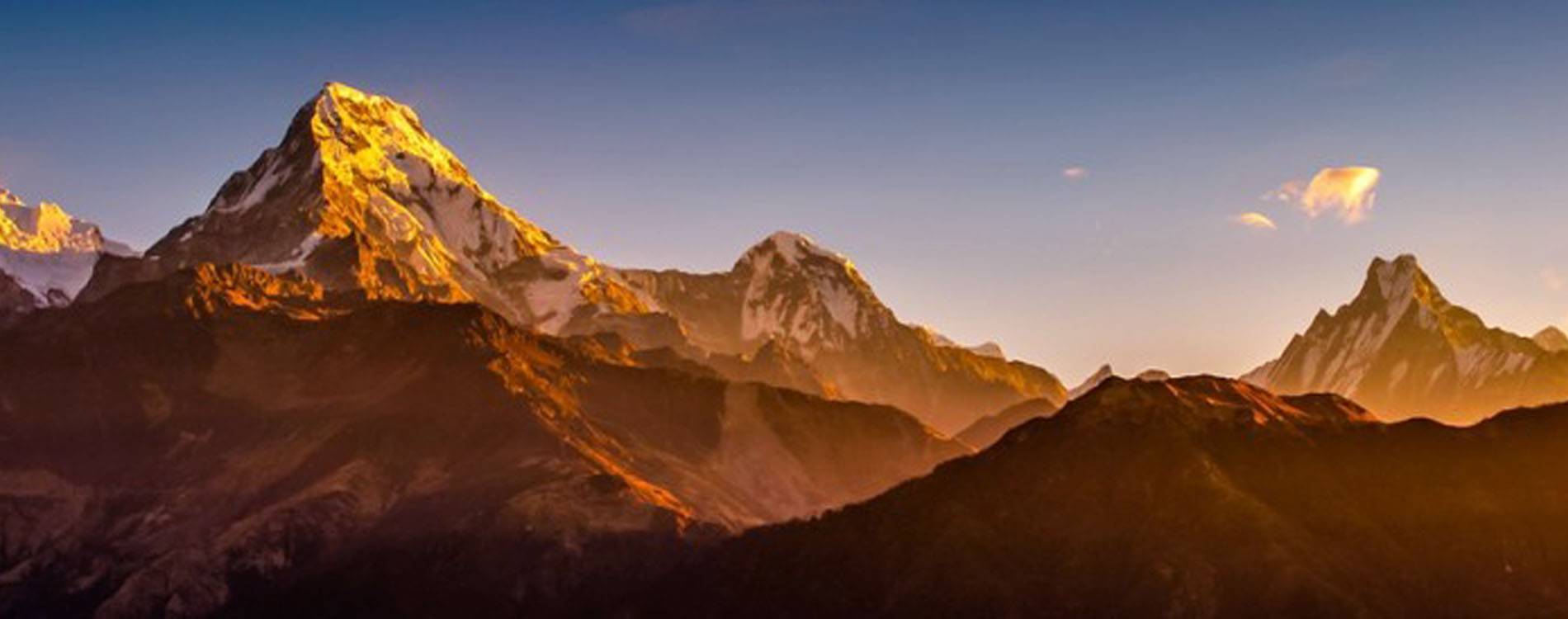
12 DAYS ANNAPURNA BASE CAMP TREK
DOUBLE THE ADVENTURE IN JUST 12 DAYS! The 12 Day Annapurna Base Camp Trek combines two well-known and popular treks into one - the Ghorepani Poon Hill Trek and the Annapurna Base Camp Trek (ABC)....
Weather and Climate Conditions
October is one of the best months to trek to Annapurna Base Camp due to its favorable weather conditions. As Nepal transitions from the monsoon season, October brings clear skies, mild temperatures, and dry weather to the region.
During October, daytime temperatures at lower elevations along the trekking route typically range from 10°C to 20°C (50°F to 68°F), providing comfortable trekking conditions without the heat of summer or the chill of winter. Evenings and mornings can be cooler, especially at higher altitudes and as trekkers ascend towards Annapurna Base Camp itself, where temperatures can drop below freezing.
The stable weather in October ensures excellent visibility for panoramic mountain views, including Annapurna I (8,091 meters), Machapuchare (6,993 meters), and other peaks that form the Annapurna Massif. Clear skies also enhance photographic opportunities and allow trekkers to fully appreciate the stunning natural beauty of the Himalayas.
While October generally experiences dry weather, occasional showers or cloud cover can still occur, particularly in early October. It's essential to pack layers of clothing that can be adjusted according to temperature changes and to be prepared with waterproof gear to handle any unexpected weather conditions.
Overall, the favorable weather conditions in October make it an ideal month for trekking to Annapurna Base Camp, ensuring a memorable and comfortable adventure amidst Nepal's spectacular mountain scenery.
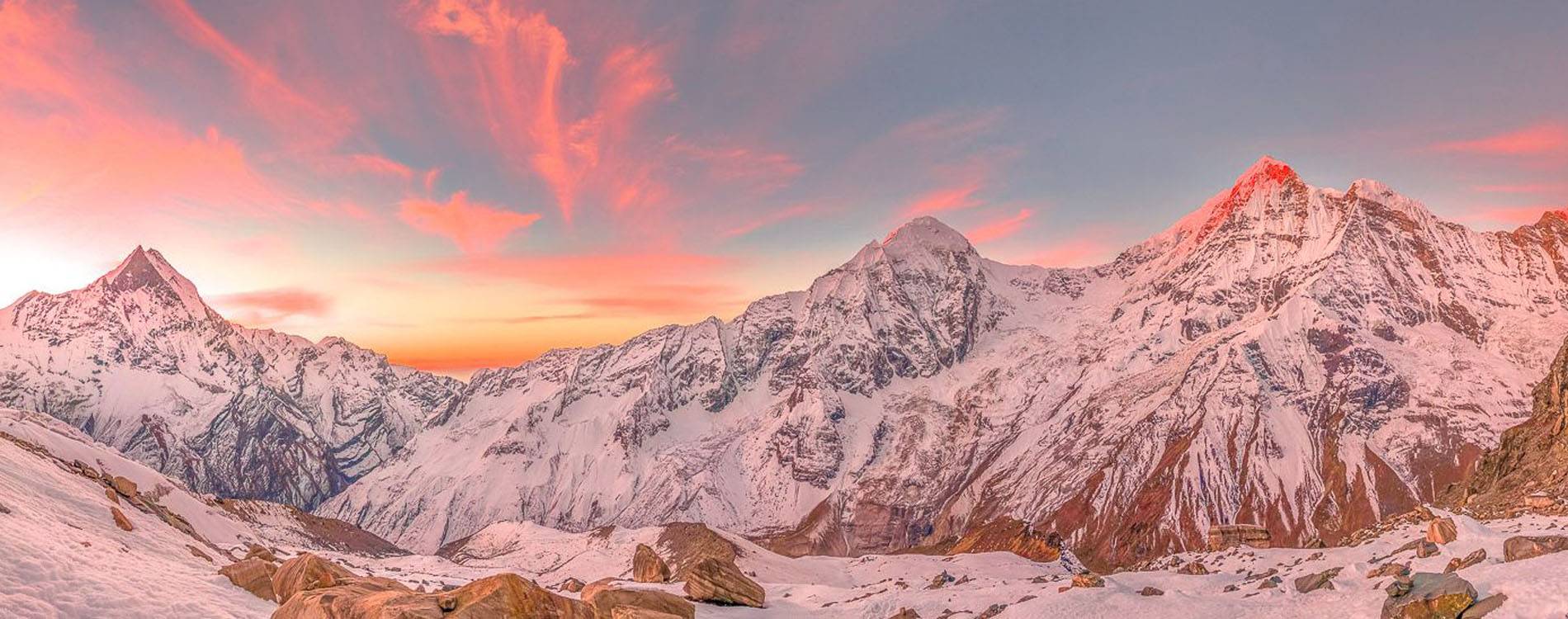
7 DAYS ANNAPURNA BASE CAMP TREK
Short on time – big on beauty!The 7 days Annapurna Base Camp Trek takes you to all the major attractions – but in less time than other treks to the Annapurna region. Take in the spectacular soaring sn...
Preparation and Packing Guide
Preparing for the Annapurna Base Camp trek in October requires careful planning and packing to ensure comfort, safety, and enjoyment throughout the journey. Here's a comprehensive packing guide:
- Clothing: Lightweight and moisture-wicking trekking shirts, thermal base layers, insulated jacket, waterproof and windproof outer shell, trekking pants, thermal underwear, gloves, beanie, and sturdy hiking boots with good ankle support.
- Gear: Backpack (30-40 liters), sleeping bag suitable for cold temperatures (0°C to -10°C), trekking poles, headlamp or flashlight with spare batteries, sunglasses with UV protection, and a wide-brimmed hat or cap.
- Personal Items: Sunscreen (SPF 30+), lip balm with SPF, personal toiletries, quick-dry towel, hand sanitizer, insect repellent, and a first aid kit with essentials like bandages, blister treatments, pain relievers, and any prescribed medications.
- Electronics: Camera with extra batteries and memory cards, mobile phone with portable charger, and possibly a portable solar charger for longer treks.
- Miscellaneous: Lightweight and quick-drying travel towel, trekking map or guidebook, reusable water bottle or hydration system, and snacks (energy bars, nuts, dried fruits) for trekking days.
- Documents: Passport (or copy), travel insurance details, permits (ACAP and TIMS card), and emergency contact information.
Pack light but efficiently, considering the variable weather conditions and the need to carry essentials comfortably during long trekking days. Prioritize items that enhance safety, comfort, and enjoyment while minimizing unnecessary weight.
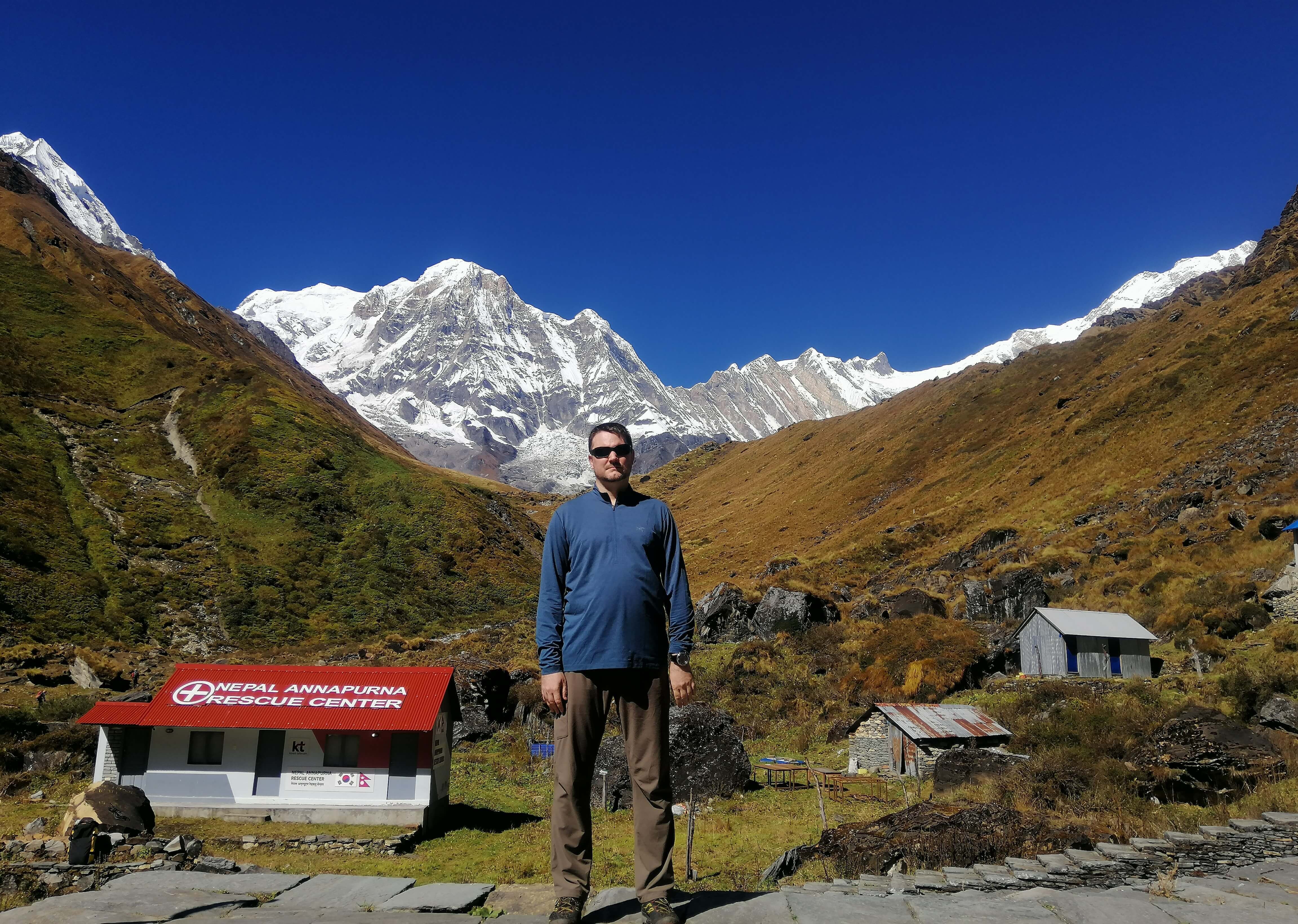
ANNAPURNA BASE CAMP TREK 16 DAYS
This 16-day Annapurna Base Camp Trek (ABC) in Nepal combines a visit to two of Nepal’s largest cities and high altitude trekking in the famous Annapurna Region. The trip starts from Kathmandu where yo...
Fitness and Training Tips
Preparing physically for the Annapurna Base Camp trek in October is essential to ensure a safe and enjoyable experience amidst the challenging Himalayan terrain. Here are some fitness and training tips to help you prepare:
- Cardiovascular Endurance: Improve your cardiovascular fitness through activities such as hiking, jogging, cycling, or swimming to build stamina for sustained trekking days.
- Strength Training: Strengthen your leg muscles, core, and upper body with exercises like squats, lunges, planks, and weightlifting to support your body during ascents and descents.
- Flexibility and Balance: Incorporate stretching exercises and yoga into your routine to improve flexibility, balance, and agility, which are crucial for navigating uneven terrain.
- Altitude Acclimatization: If possible, acclimatize gradually by trekking at higher altitudes before your Annapurna Base Camp trek to help your body adjust to reduced oxygen levels and minimize the risk of altitude sickness.
- Hydration and Nutrition: Maintain a balanced diet rich in carbohydrates, proteins, and healthy fats to fuel your training and trekking activities. Stay hydrated by drinking plenty of water throughout the day.
- Practice Trekking with a Backpack: Train with a loaded backpack to simulate the weight you'll carry during the trek. Start with lighter loads and gradually increase the weight as you build strength and endurance.
- Rest and Recovery: Allow for adequate rest days between training sessions to prevent overtraining and promote muscle recovery. Listen to your body and adjust your training intensity as needed.
By committing to a well-rounded training regimen that includes cardiovascular fitness, strength training, flexibility exercises, and altitude acclimatization, you'll be better prepared physically and mentally to tackle the challenges and fully enjoy the breathtaking landscapes of the Annapurna region.

ANNAPURNA BASE CAMP TREK 9 DAYS
The Annapurna Base Camp (ABC) (4130m) is also known as the "Annapurna Sanctuary Trek". This trek promises “in-your-face” unprecedented views of colossal Himalaya ranges, which include Hiunchuli, Macha...
Permits and Regulations
Before embarking on the Annapurna Base Camp trek in October, it's crucial to obtain the necessary permits and understand the regulations in place to ensure a smooth and compliant journey. Trekkers need two main permits: the Annapurna Conservation Area Permit (ACAP) and the Trekker's Information Management System (TIMS) card. These permits can be obtained in Kathmandu or Pokhara through authorized trekking agencies or the Nepal Tourism Board. The fees collected from permits contribute to the conservation and maintenance of the trekking trails and surrounding natural environment.
It's essential to carry these permits at all times during the trek, as they may be checked at various checkpoints along the route. Trekkers should also respect local customs and regulations, such as waste management practices and cultural sensitivities in villages and sacred sites along the trail. By adhering to these regulations, trekkers contribute to the preservation of the Annapurna region's natural beauty and cultural heritage, ensuring future generations can continue to enjoy this pristine Himalayan sanctuary.
Accommodation Options Along the Trail
During the Annapurna Base Camp trek in October, trekkers have a variety of accommodation options ranging from basic teahouses to more comfortable lodges, depending on the route and location along the trail. Teahouses are the most common form of accommodation, offering simple rooms with shared bathrooms and communal dining areas where trekkers can enjoy hearty meals and socialize with fellow adventurers.
As you ascend towards higher altitudes, accommodation options may become more limited and basic, with fewer amenities available. It's advisable to book accommodation in advance, especially during peak trekking season in October, to secure a place to stay each night along the route.
In popular trekking villages like Ghorepani, Tadapani, Chhomrong, and Machapuchare Base Camp, trekkers can find a range of teahouses offering meals such as dal bhat (rice and lentils), noodles, soups, and local specialties. Some lodges may also provide hot showers and charging facilities for electronic devices, although amenities can vary widely depending on the location.
Staying in teahouses not only provides essential shelter and meals but also offers opportunities to interact with local hosts and fellow trekkers, sharing stories and experiences from the trail. Overall, the accommodation options along the Annapurna Base Camp trek in October cater to various budgets and preferences, ensuring a comfortable and memorable trekking experience amidst Nepal's stunning Himalayan landscapes.
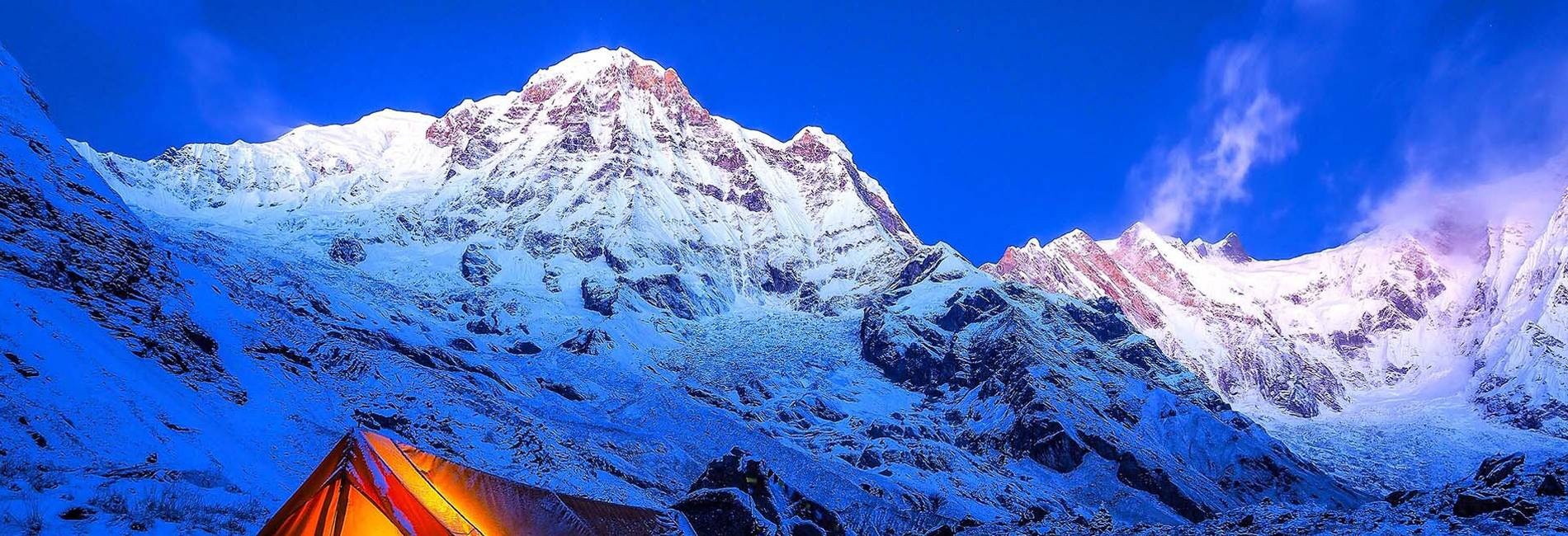
ANNAPURNA BASE CAMP TREK 8 DAYS
The 8 days Annapurna Base Camp Trek is the most popular and amazing trek in the Annapurna region which offers combines remarkable Himalaya vistas, traditional Gurung and Magar village life, and dense...
Food and Dining Experiences
Exploring the culinary delights along the Annapurna Base Camp trek in October adds a flavorful dimension to the trekking experience, offering trekkers a taste of traditional Nepali and Himalayan cuisine. Throughout the journey, teahouses and lodges along the trail serve as essential refueling stations, providing hearty meals to replenish energy after long days of trekking.
Dal bhat, a staple dish of rice and lentils accompanied by vegetables, pickles, and sometimes meat, is a popular choice among trekkers for its nutritional value and filling nature. Other menu items often include noodles, soups (such as Sherpa stew), momos (dumplings filled with meat or vegetables), and Tibetan bread. These meals are prepared fresh using local ingredients, ensuring a satisfying dining experience amidst the stunning mountain scenery.
In addition to local cuisine, teahouses also offer a variety of beverages including tea, coffee, hot chocolate, and soft drinks, as well as alcoholic beverages in some locations. Trekkers are encouraged to stay hydrated with plenty of water and consider bringing water purification tablets or a filtering device for safe drinking water along the trail.
While dining options may be more limited at higher altitudes, teahouses strive to accommodate dietary preferences and restrictions when possible. It's advisable to inform hosts of any dietary requirements in advance to ensure meals meet personal needs.
Overall, dining along the Annapurna Base Camp trek in October offers trekkers not only sustenance but also an opportunity to savor local flavors, share meals with fellow adventurers, and experience the hospitality of Nepal's mountain communities amidst breathtaking Himalayan landscapes.
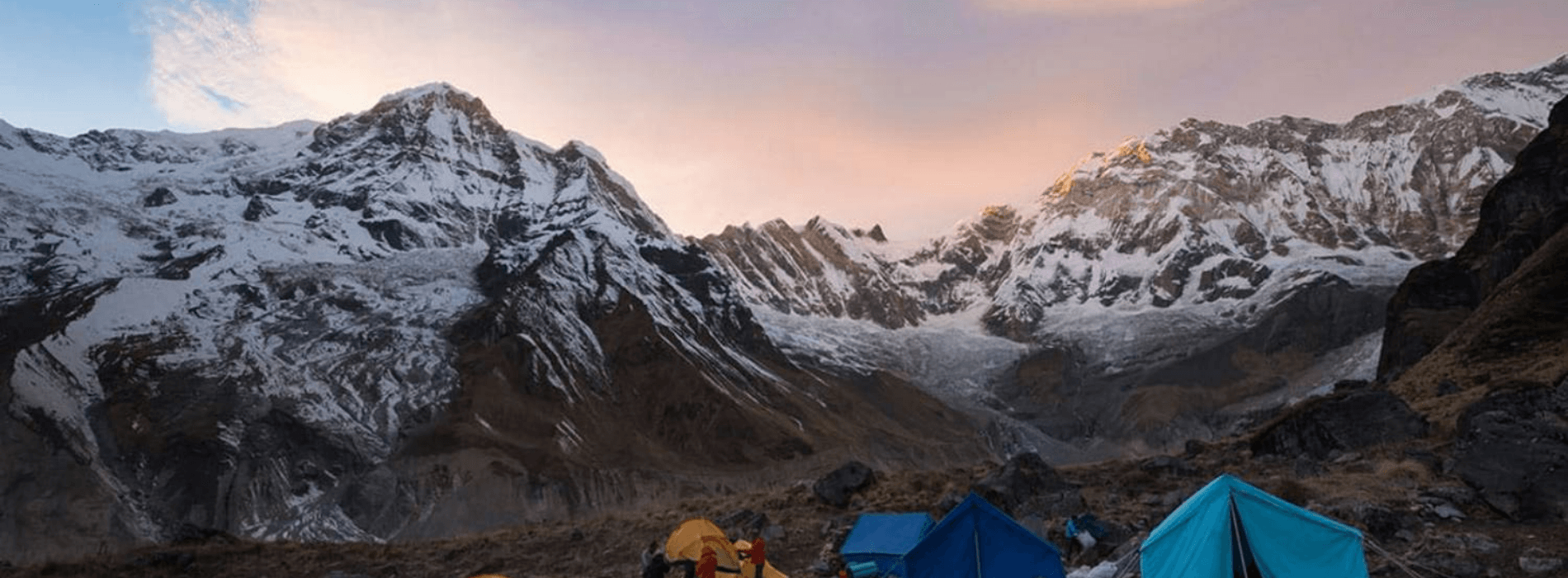
ANNAPURNA BASE CAMP TREK 6 DAYS
The 6 days Annapurna Base Camp Trek is an ideal adventure for those people who have a tight schedule but still want to experience the amazing landscape and the fascinating lifestyles of the Gurung cul...
Cultural Insights and Local Customs
Trekking to Annapurna Base Camp in October not only promises stunning natural beauty but also offers rich cultural insights into the traditions and customs of the Nepalese Himalayas. Along the trail, trekkers encounter diverse ethnic communities, primarily Gurung and Magar, known for their warm hospitality and distinct cultural practices. These communities often welcome trekkers with traditional greetings like "Namaste" and offer insights into their daily lives through homestay experiences or cultural programs organized by teahouses.
Local customs such as prayer flag etiquette and respect for sacred sites are integral to the cultural landscape of the region. It's customary to walk clockwise around stupas and mani walls, to avoid stepping over offerings, and to ask for permission before photographing people or religious ceremonies. Understanding and respecting these customs not only fosters positive interactions but also contributes to sustainable tourism practices in the area.
Moreover, trekking during local festivals like Dashain and Tihar provides a deeper cultural immersion, with opportunities to witness traditional rituals, dances, and festivities celebrated by local communities. Engaging with local guides or interpreters enhances the cultural experience, offering insights into the spiritual beliefs, folklore, and agricultural traditions that shape life in the Himalayan villages.
By embracing cultural diversity and respecting local customs along the Annapurna Base Camp trek in October, trekkers can forge meaningful connections with the communities they encounter and gain a deeper appreciation for Nepal's rich cultural heritage amidst the spectacular mountain scenery.
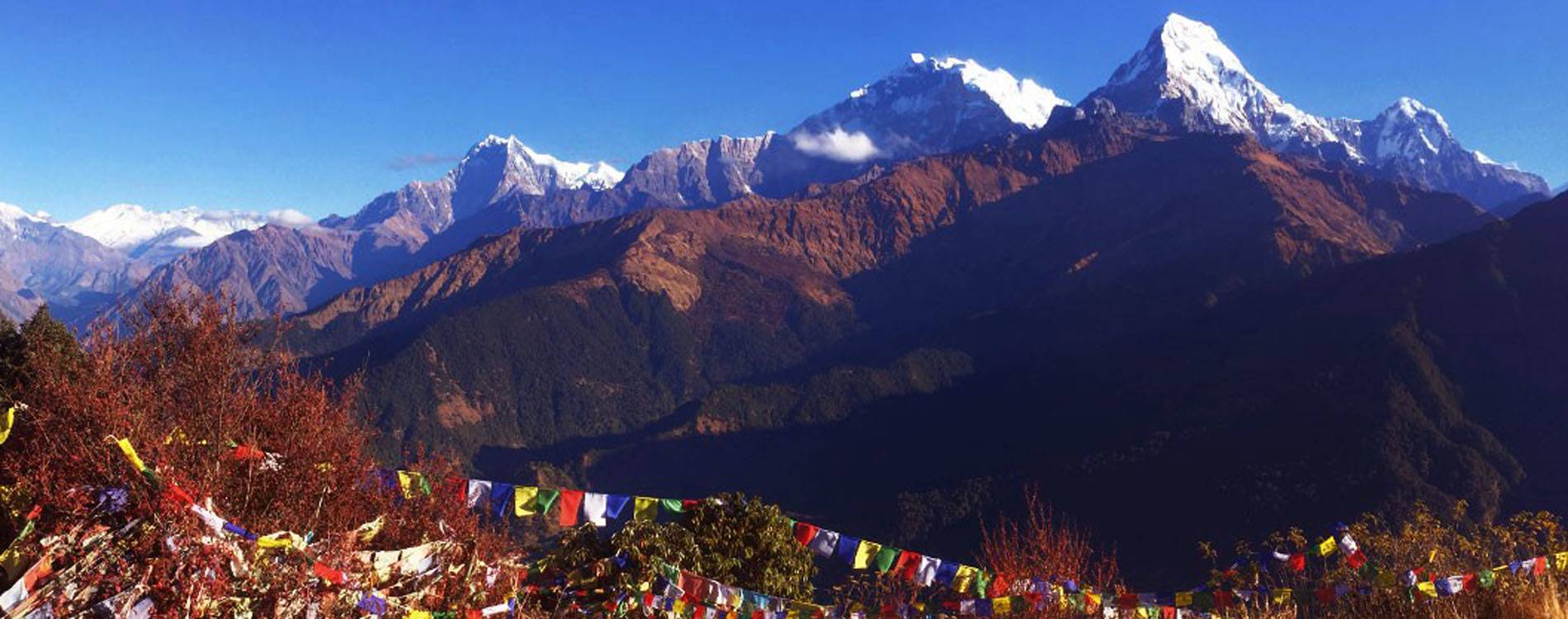
7 DAYS GHOREPANI POON HILL TREK
“THIS IS ONE TREK NOT TO BE MISSED!”A MIND-BLOWING HEAVEN ON-EARTH EXPERIENCE THAT WILL TAKE YOUR BREATH AWAY! SOARING MAJEST...
Photography Tips for Capturing the Trek
Capturing the breathtaking landscapes and memorable moments during the Annapurna Base Camp trek in October requires thoughtful photography techniques to preserve the essence of this Himalayan adventure. Here are some tips to enhance your photography experience:
- Golden Hours: Make the most of the soft, warm light during sunrise and sunset to capture dramatic mountain silhouettes and vibrant sky colors. These hours provide optimal lighting conditions for stunning landscape photography.
- Use a Wide-angle Lens: A wide-angle lens is ideal for capturing expansive mountain vistas and sweeping panoramic views of the Annapurna range. It helps to convey the vastness and grandeur of the Himalayan landscape.
- Include Foreground Elements: Incorporate foreground elements such as trekking trails, prayer flags, or local flora to add depth and context to your photographs. These elements create visual interest and lead the viewer's eye into the scene.
- Capture Cultural Interactions: Documenting interactions with local communities, traditional ceremonies, and daily life scenes adds a human element to your photographic narrative. Always ask for permission before photographing people and respect their privacy.
- Experiment with Perspectives: Explore different angles and viewpoints to capture unique compositions that showcase the rugged terrain, changing weather patterns, and diverse flora and fauna along the trekking route.
- Pack Essential Gear: Carry extra batteries, memory cards, lens cleaning kit, and a sturdy camera bag or waterproof cover to protect your equipment from dust and moisture. October weather in the Himalayas can be unpredictable, so it's essential to be prepared.
- Tell a Story: Use your photographs to tell a compelling story of your trekking experience, from the initial excitement of starting the trek to the sense of achievement upon reaching Annapurna Base Camp. Capture moments that evoke emotions and convey the challenges and beauty of the journey.
By applying these photography tips and techniques, you can create captivating images that not only document your Annapurna Base Camp trek in October but also inspire others to explore this remarkable trekking destination in Nepal's Himalayas.
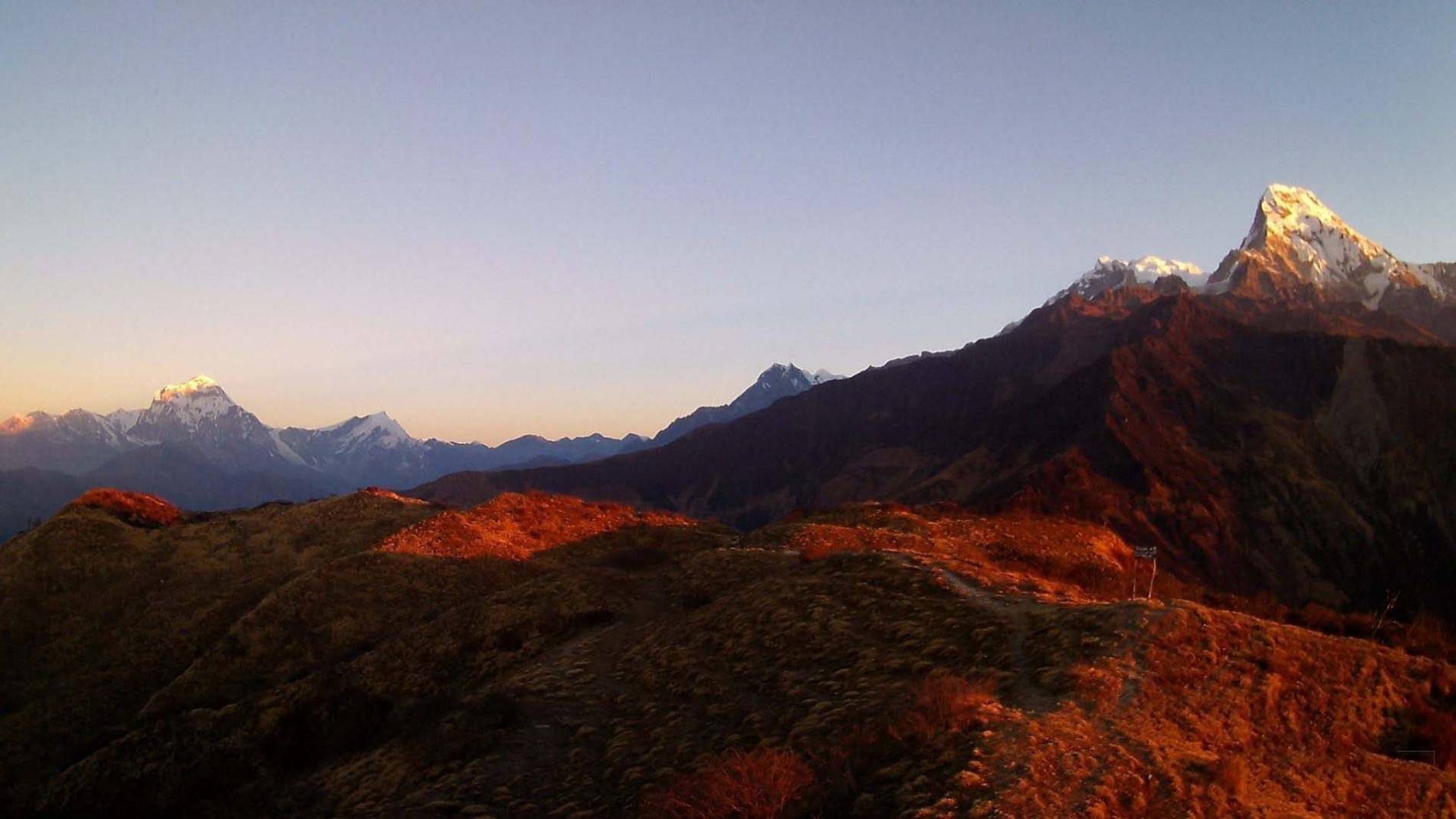
KHOPRA DANDA TREK
SOLITUDE & BEAUTY WITH FEWER TOURISTS & A SMORGASBORD OF MOUNTAINS TO FEAST YOUR EYES ON!The newly opened Khopra Danda Trek in a remote part of the Annapurna region offers unspoiled natural be...
Safety Tips and Considerations
Trekking to Annapurna Base Camp in October offers breathtaking vistas but requires careful preparation to ensure a safe and enjoyable journey. Here are essential safety tips:
- Acclimatization: Gradually ascend to higher altitudes to acclimatize properly. Take rest days to allow your body to adjust to reduced oxygen levels, reducing the risk of altitude sickness.
- Weather Awareness: October generally has stable weather, but conditions can change quickly in the mountains. Be prepared for temperature drops, wind, and occasional rain or snow. Carry adequate layers of clothing and waterproof gear.
- Hydration and Nutrition: Stay hydrated by drinking plenty of water throughout the day, even if you don't feel thirsty. Eat balanced meals rich in carbohydrates, proteins, and fats to fuel your trekking activities.
- Trekking in Groups: Trekking with a guide or in a group enhances safety, especially in remote areas. Stay on marked trails, avoid solo trekking in unfamiliar areas, and inform someone of your itinerary.
- First Aid Kit: Carry a basic first aid kit with essential medications, bandages, blister treatments, and personal medications. Know how to use the items in your kit.
- Emergency Contacts: Keep a list of emergency contacts, including local authorities, trekking agencies, and embassy numbers. Ensure your mobile phone is charged and consider carrying a portable charger.
By prioritizing safety and taking necessary precautions, you can minimize risks and fully enjoy the stunning landscapes and cultural experiences of the Annapurna Base Camp trek in October.
Altitude Sickness: Symptoms and Prevention
Altitude sickness, or acute mountain sickness (AMS), can affect trekkers ascending to high altitudes like Annapurna Base Camp (4,130 meters). Recognizing symptoms early and taking preventive measures are crucial:
- Symptoms: Headache, nausea, dizziness, fatigue, shortness of breath, and difficulty sleeping are common symptoms of AMS. More severe forms include High Altitude Pulmonary Edema (HAPE) and High Altitude Cerebral Edema (HACE).
- Preventive Measures: Ascend gradually, allowing time for acclimatization. Drink plenty of fluids, avoid alcohol, and eat light, high-carbohydrate meals. Consider taking medications like acetazolamide (Diamox) under medical supervision.
- Recognizing Symptoms: Monitor your health and be honest about how you're feeling. If symptoms worsen, descend to a lower altitude immediately. Rest and acclimatize before continuing your ascent.
- Safety in Numbers: Trek with others who can monitor your condition. Inform your guide or fellow trekkers if you experience symptoms of AMS. Guides are trained to recognize and respond to altitude sickness.
- Emergency Response: In severe cases, descend immediately and seek medical attention. Carry a portable oxygen cylinder if trekking independently. Local clinics in trekking villages can provide basic medical care.
By understanding altitude sickness and taking preventive measures, you can safely enjoy the challenges and rewards of trekking to Annapurna Base Camp in October, ensuring a memorable and safe Himalayan adventure.
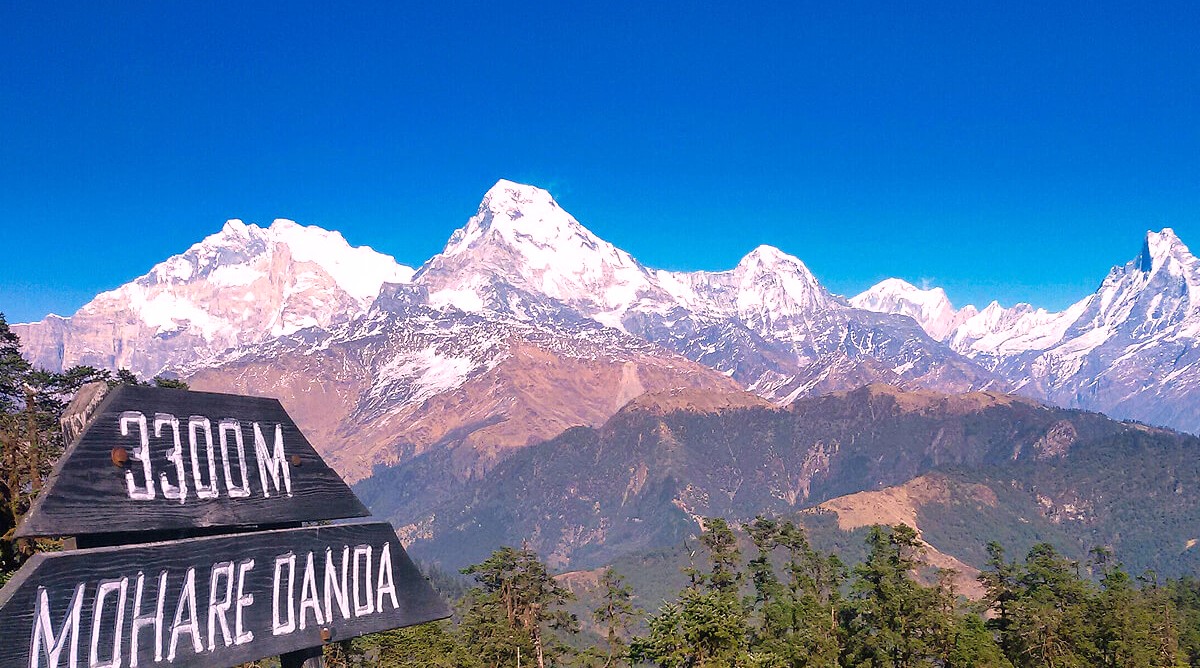
KHOPRA DANDA TREK 8 DAYS
SOLITUDE & BEAUTY WITH FEWER TOURISTS & A SMORGASBORD OF MOUNTAINS TO FEAST YOUR EYES ON!The newly opened Khopra Danda With Mohare Hill Trek in a remote part of the Annapurna re...
Flora and Fauna Along the Trail
The Annapurna Base Camp trek in October showcases a diverse range of flora and fauna, adding a natural dimension to the trekking experience. As trekkers ascend through various ecological zones, they encounter distinct vegetation and wildlife:
- Lower Elevations: Begin with lush forests of rhododendron, oak, and bamboo, adorned with colorful blooms in October. These forests are home to diverse bird species like pheasants, sunbirds, and cuckoos.
- Alpine Zones: Ascending higher, the landscape transitions to alpine meadows dotted with Himalayan flowers like gentians and primulas. Keep an eye out for mammals such as Himalayan thars, langur monkeys, and occasionally, elusive snow leopards.
- Glacial Moraines: Near Annapurna Base Camp, trekkers traverse rocky terrain and glacial moraines, where hardy plants like mosses and lichens thrive. This stark landscape offers breathtaking views of surrounding peaks and glaciers.
- Conservation Efforts: The Annapurna Conservation Area Project (ACAP) promotes biodiversity conservation, ensuring the preservation of flora and fauna along the trekking route. Respect local regulations and avoid disturbing wildlife for a sustainable trekking experience.
- Photographic Opportunities: Capture the natural beauty of Annapurna's flora and fauna with a camera or binoculars. Early morning and late afternoon provide optimal lighting for photography, showcasing vibrant colors and wildlife in their natural habitat.
Exploring the flora and fauna along the Annapurna Base Camp trek in October enriches the trekking experience, offering glimpses into Nepal's rich biodiversity amidst awe-inspiring Himalayan landscapes.
Famous Landmarks and Viewpoints
Trekking to Annapurna Base Camp in October rewards adventurers with iconic landmarks and breathtaking viewpoints that define the Himalayan experience. One of the most renowned landmarks along the trek is Machapuchare Base Camp (MBC), nestled at an altitude of around 3,700 meters. This site offers stunning views of Machapuchare (Fishtail) Mountain, a sacred peak revered by locals and trekkers alike for its distinct fishtail-shaped summit.
Another highlight is Poon Hill, a popular viewpoint renowned for its panoramic sunrise views over the Annapurna and Dhaulagiri mountain ranges. Trekkers often ascend Poon Hill in the early morning to witness the sun casting hues of pink and gold over snow-capped peaks, creating a mesmerizing spectacle.
Upon reaching Annapurna Base Camp (ABC) itself, trekkers are greeted by an amphitheater of towering peaks, including Annapurna I (8,091 meters), Annapurna South (7,219 meters), and Hiunchuli (6,441 meters). The expansive glacial basin of ABC offers unparalleled photo opportunities and a sense of accomplishment amidst Nepal's highest mountains.
These landmarks and viewpoints not only provide memorable photographic moments but also evoke a profound appreciation for the natural beauty and grandeur of the Annapurna region. Trekking in October ensures clear skies and optimal visibility, enhancing the awe-inspiring experience of witnessing these famous landmarks in all their majestic glory.
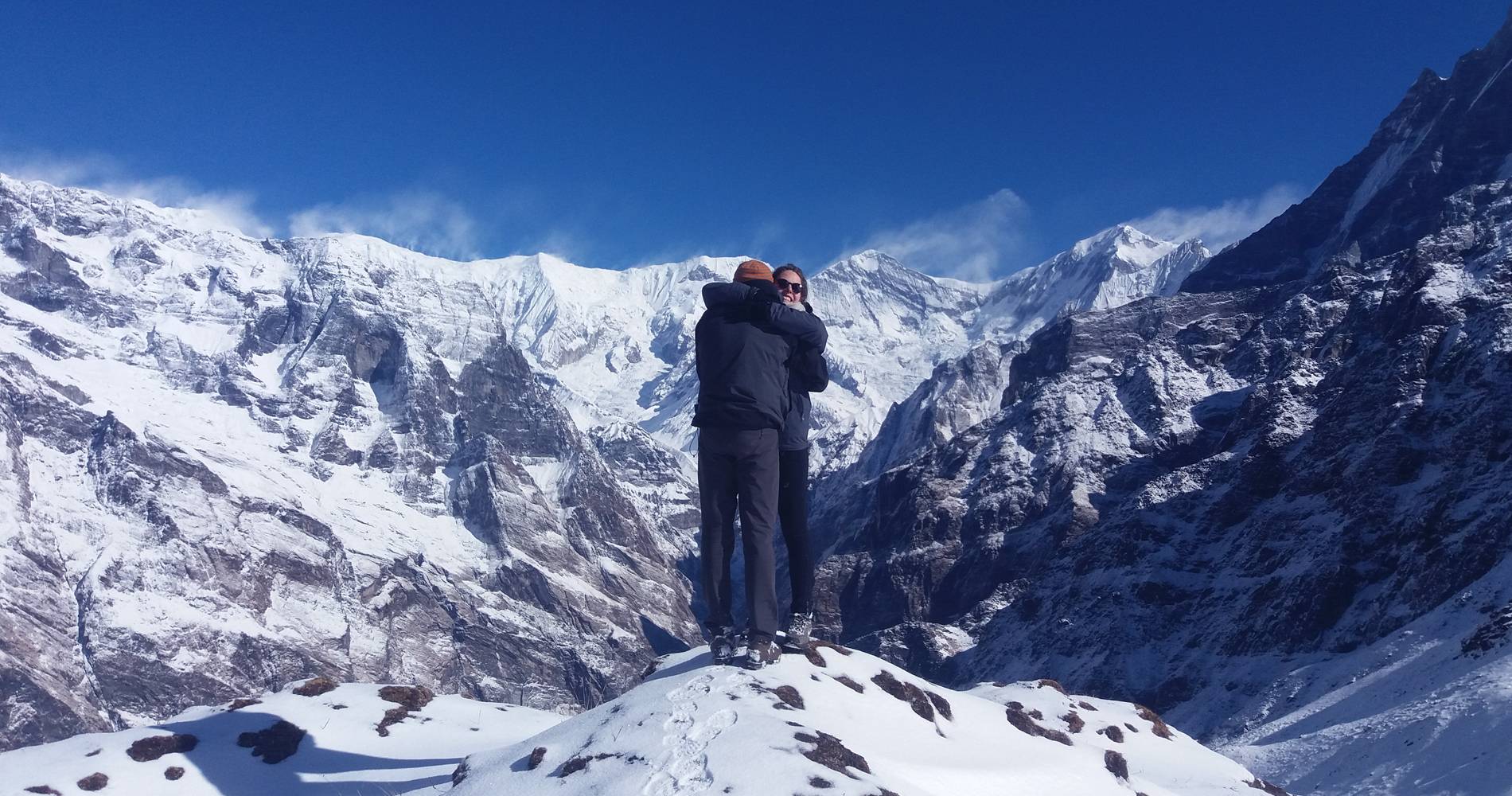
MARDI HIMAL TREK 7 DAYS
Are you seeking a less travelled route into the famous Himalayan Mountains? This is the perfect trek taking you through lush valleys, high altitude alpine meadows, lichen-laden dense forests, across m...
Community and Village Encounters
Trekking to Annapurna Base Camp in October offers trekkers not only the chance to immerse themselves in stunning natural landscapes but also to engage with local communities and experience authentic village life along the trail. Throughout the trek, trekkers pass through several Gurung and Magar villages, each with its own unique cultural traditions and warm hospitality.
Village encounters provide trekkers with insights into rural Nepalese life, from traditional farming practices to daily rituals and celebrations. Local tea houses and lodges offer opportunities to interact with villagers, learn about their customs, and sample delicious home-cooked meals prepared with locally sourced ingredients.
Visiting villages like Chhomrong, Bamboo, and Sinuwa allows trekkers to appreciate the resilience and warmth of the Himalayan communities living amidst challenging terrain. Trekkers can participate in cultural exchanges, such as attending village ceremonies or learning traditional dances, which deepen their understanding of local traditions and foster meaningful connections with villagers.
Engaging respectfully with local communities by supporting local businesses, respecting cultural norms, and learning basic Nepali greetings enhances the trekking experience. These interactions not only enrich the journey but also contribute to sustainable tourism practices that benefit local economies and preserve cultural heritage.
Overall, community and village encounters along the Annapurna Base Camp trek in October offer trekkers a glimpse into the heart of Nepal's Himalayan culture, making it a rewarding and unforgettable adventure in the majestic Annapurna region.
Equipment and Gear Reviews
Preparing for the Annapurna Base Camp trek in October requires careful consideration of essential equipment and gear to ensure comfort, safety, and enjoyment throughout the journey. Here's a review of key items you'll need:
- Footwear: Invest in sturdy, waterproof hiking boots with good ankle support. Break them in before the trek to prevent blisters and ensure comfort during long days of walking.
- Clothing: Pack lightweight, moisture-wicking base layers, insulating mid-layers, and a waterproof and windproof outer shell. Include thermal underwear, gloves, a beanie, and sunglasses for protection against cold and sun.
- Backpack: Choose a comfortable, well-fitted backpack (30-40 liters) with padded straps and a hip belt to distribute weight evenly. Consider a rain cover to protect your gear from unexpected showers.
- Sleeping Bag: Opt for a sleeping bag rated for cold temperatures (0°C to -10°C) to stay warm at higher altitudes. Lightweight and compressible options are ideal for trekking.
- Trekking Poles: Bring trekking poles for stability and to reduce strain on knees and joints during steep ascents and descents.
- Personal Essentials: Pack a headlamp or flashlight with spare batteries, a reusable water bottle or hydration system, sunscreen (SPF 30+), lip balm with SPF, personal toiletries, and a first aid kit with essentials like bandages, blister treatments, and any prescribed medications.
- Electronics: Carry a camera with extra batteries and memory cards to capture stunning landscapes along the trek. A portable charger or solar panel can keep devices powered in remote areas.
Choosing lightweight, durable gear tailored to the October weather conditions ensures you're well-equipped for the challenges and rewards of trekking to Annapurna Base Camp. Prioritize quality and functionality to enhance your trekking experience amidst Nepal's awe-inspiring Himalayan scenery.
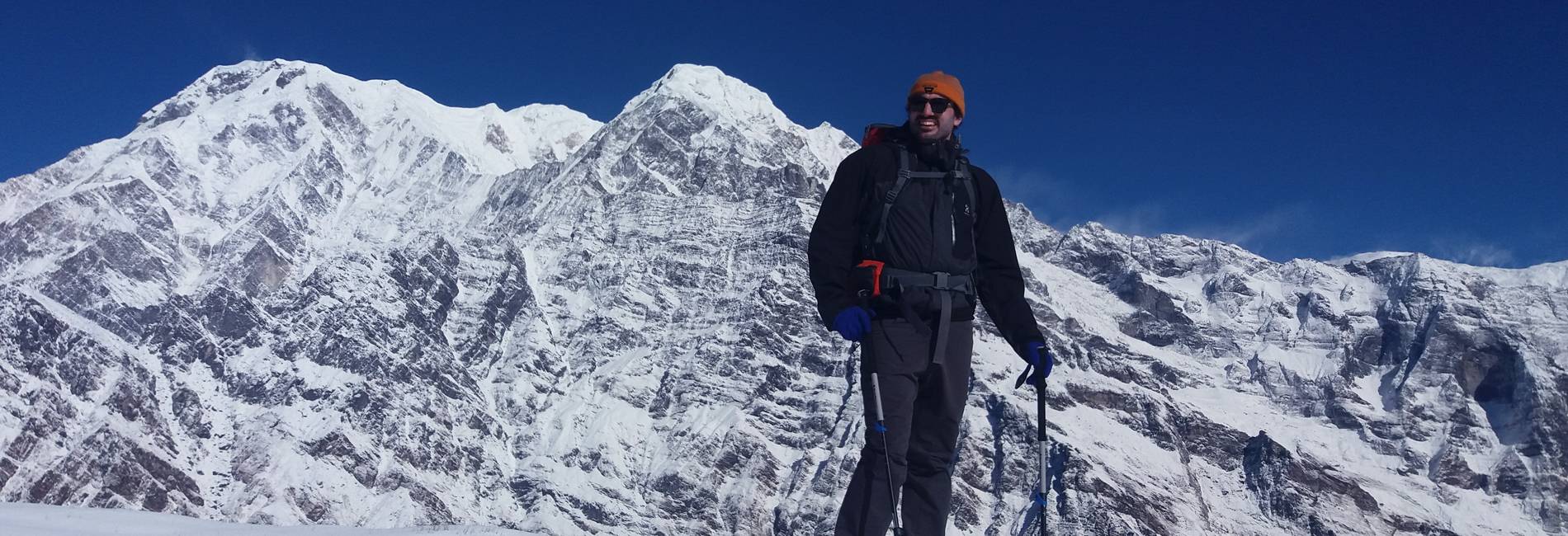
MARDI HIMAL TREK
Enjoy the feeling of solitude as you trek in this remote less traveled region.Fewer tourists, but big on beauty! Snowcapped peaks abound as you enjoy this off-the-beaten-path trek that is full of...
Budgeting and Cost Breakdown
Planning the budget for your Annapurna Base Camp trek in October is essential to ensure a smooth and enjoyable journey without financial stress. Here’s a breakdown of potential costs:
- Permits: Obtain the necessary permits, including the Annapurna Conservation Area Permit (ACAP) and Trekker's Information Management System (TIMS) card. Costs vary but typically range around NPR 3,000 to 4,000 (USD 25-35) in total.
- Accommodation: Budget for nightly stays in teahouses along the trail. Prices range from NPR 500 to 1,500 (USD 4-12) per night, depending on the location and amenities.
- Food: Plan for meals at teahouses, which offer simple but hearty dishes like dal bhat (rice and lentils), noodles, and soups. Budget around NPR 500 to 1,000 (USD 4-8) per meal.
- Transportation: Consider costs for transportation to and from Pokhara, the starting point for many Annapurna treks. Bus fares from Kathmandu to Pokhara range from NPR 500 to 2,000 (USD 4-16) depending on the type of bus and season.
- Guides and Porters: Hiring a guide and/or porter is optional but recommended for safety and support. Guide fees vary, averaging around USD 20-25 per day, while porter fees range from USD 15-20 per day, including their accommodation and meals.
- Miscellaneous: Factor in expenses for snacks, drinks, trekking gear rental or purchase, tips for guides and porters, and unforeseen expenses.
By planning and budgeting accordingly, you can estimate total costs for your Annapurna Base Camp trek in October and enjoy the experience without financial concerns, ensuring a memorable adventure amidst Nepal's stunning Himalayan landscapes.
Transportation to and from Pokhara
Pokhara serves as the gateway to the Annapurna Base Camp trek in October, offering various transportation options from major cities like Kathmandu and other parts of Nepal. Here's how to navigate your journey to and from Pokhara:
- By Air: Tribhuvan International Airport in Kathmandu offers daily flights to Pokhara Airport, providing a convenient but more expensive option. The flight duration is approximately 25-30 minutes, offering stunning aerial views of the Himalayas.
- By Road: The most common and cost-effective way to reach Pokhara is by road. Tourist buses depart daily from Kathmandu's Gongabu Bus Park, taking about 6-8 hours depending on road conditions and stops. Private taxis and shared jeeps are also available for a quicker but pricier journey.
- Local Transport: Once in Pokhara, taxis and local buses can take you to the trekking trailheads, such as Nayapul or Phedi, where your Annapurna Base Camp adventure begins. Local buses are economical but may be crowded and less frequent.
Planning your transportation to and from Pokhara in advance ensures a smooth start and end to your trekking experience. Consider booking flights or buses early during the peak season in October to secure your preferred schedule and enjoy hassle-free travel amidst Nepal's spectacular mountain scenery.
Side Trips and Alternative Routes
Exploring side trips and alternative routes during your Annapurna Base Camp trek in October offers opportunities to enhance your adventure and discover hidden gems along the way:
- Poon Hill: One of the most popular side trips, Poon Hill offers panoramic sunrise views of the Annapurna and Dhaulagiri ranges. It's accessible from Ghorepani and adds an extra day to your itinerary.
- Khayer Lake: This lesser-known trekking route branches off from the main Annapurna Sanctuary trail near Tadapani. The trek leads to Khayer Lake, nestled beneath Annapurna South, offering serene landscapes and fewer crowds.
- Mardi Himal Trek: An alternative route starting from Kande, near Pokhara, the Mardi Himal trek offers stunning views of Mardi Himal and Machapuchare. It's a less frequented trail with pristine forests and alpine meadows.
Choosing side trips or alternative routes depends on your trekking experience, time constraints, and interest in exploring diverse landscapes. Consult with experienced guides or tour operators to plan side trips that complement your Annapurna Base Camp trek, ensuring a well-rounded Himalayan adventure.

ANNAPURNA BASE CAMP TREK 11 DAYS
The 11 day Annapurna Base Camp Trek is one of the most popular treks and destinations in Nepal and will take you into the protected Annapurna Conservation Area with its beautiful scenery and will give...
Best Tour Operators and Guides
Selecting the best tour operators and guides for your Annapurna Base Camp trek in October is crucial for a safe, enjoyable, and memorable journey through Nepal's Himalayas:
- Local Expertise: Look for tour operators with extensive experience and knowledge of the Annapurna region. Local guides often have intimate knowledge of the trails, cultural insights, and safety protocols.
- Reputation and Reviews: Research tour operators online and read reviews from previous trekkers. Positive reviews and recommendations indicate reliable service and customer satisfaction.
- Certifications and Training: Ensure that guides are certified by the Nepal Tourism Board and have appropriate training in first aid and altitude sickness management. Experienced guides can enhance your trekking experience with their expertise and support.
- Customizable Itineraries: Choose tour operators that offer flexible itineraries tailored to your preferences and fitness level. They should provide clear information on costs, inclusions, and optional extras like porter services or equipment rental.
- Safety Measures: Inquire about safety measures implemented during the trek, including emergency evacuation plans and communication devices. Reliable operators prioritize client safety and well-being.
By selecting reputable tour operators and knowledgeable guides, you can embark on the Annapurna Base Camp trek with confidence, knowing you're in capable hands. Their expertise and local insights will enrich your journey, ensuring a fulfilling Himalayan adventure amidst Nepal's awe-inspiring landscapes.
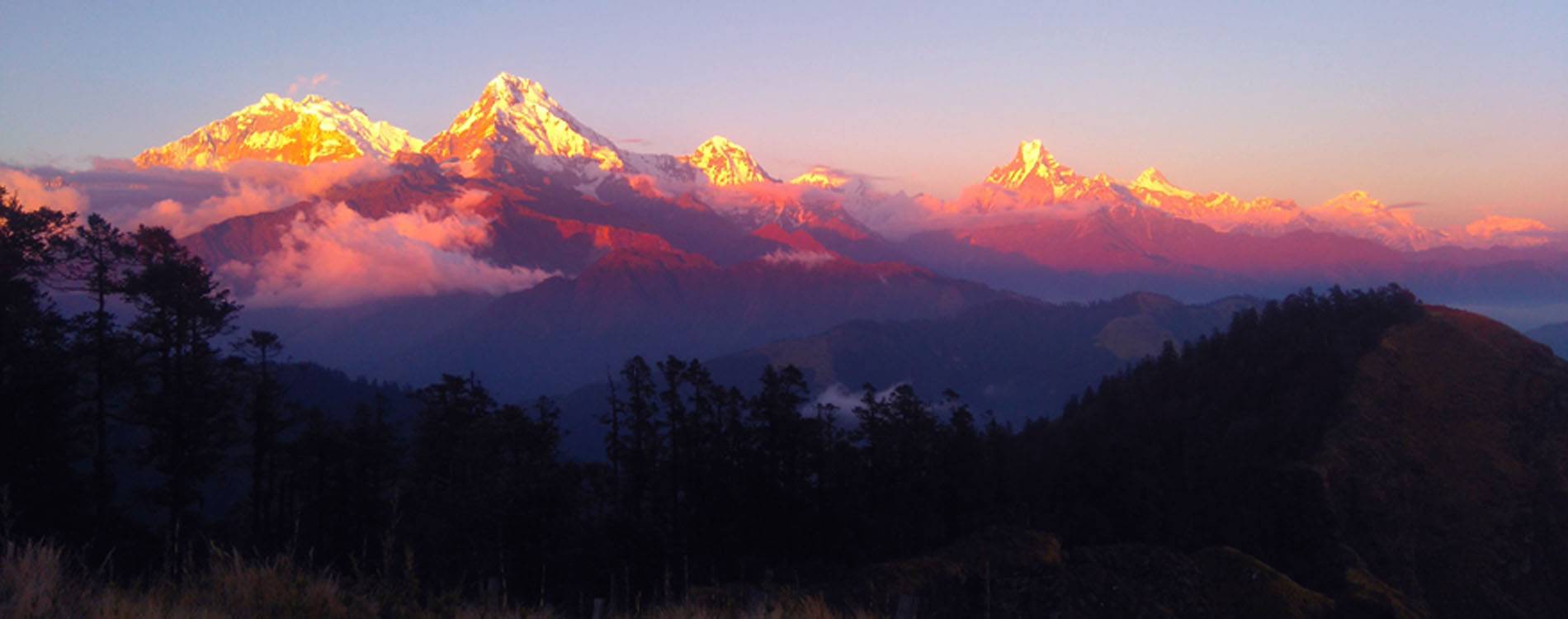
5 DAYS GHOREPANI POON HILL TREK
A FEAST FOR THE EYES & FOOD FOR THE SOUL!A short scenic trek that is big on beauty while leaving you with lasting memories of this unique location. Our 5 day Ghorepani Poon Hill trek offers the be...
Conclusion
Embarking on the Annapurna Base Camp trek in October promises a transformative adventure amidst Nepal's majestic Himalayas. From the vibrant culture of local communities to the awe-inspiring landscapes of the Annapurna Sanctuary, every step of the journey offers moments of wonder and discovery.
Whether you choose to trek through traditional villages, capture sunrise views from Poon Hill, or explore alternative routes like Khayer Lake or Mardi Himal, each path leads to breathtaking vistas and unforgettable experiences. Engaging with local guides and tour operators ensures a safe and enriching journey, while exploring side trips adds depth to your adventure.
As you traverse rugged terrain and ascend to Annapurna Base Camp, surrounded by towering peaks and glacial valleys, take time to appreciate the natural beauty and cultural heritage that define this region. Each day brings new challenges and rewards, from encountering diverse flora and fauna to forging connections with fellow trekkers.
Ultimately, the Annapurna Base Camp trek in October is not just about reaching a destination but about embracing the journey itself—immersing yourself in the sights, sounds, and spirit of the Himalayas. Whether you trek for adventure, personal achievement, or spiritual fulfillment, this journey leaves an indelible mark, forever woven into the fabric of your memories.
In conclusion, may your Annapurna Base Camp trek in October be filled with wonder, resilience, and moments of profound joy, offering a glimpse into the boundless beauty of Nepal's mountain landscapes.
Annapurna Base Camp Trekking packages
14 Days Annapurna Base Camp Trek
13 Days Annapurna Base Camp Trek
12 Days Annapurna Base Camp Trek
9 Days Annapurna Base Camp Trek
7 Days Annapurna Base Camp Trek
6 Days Annapurna Base Camp Trek
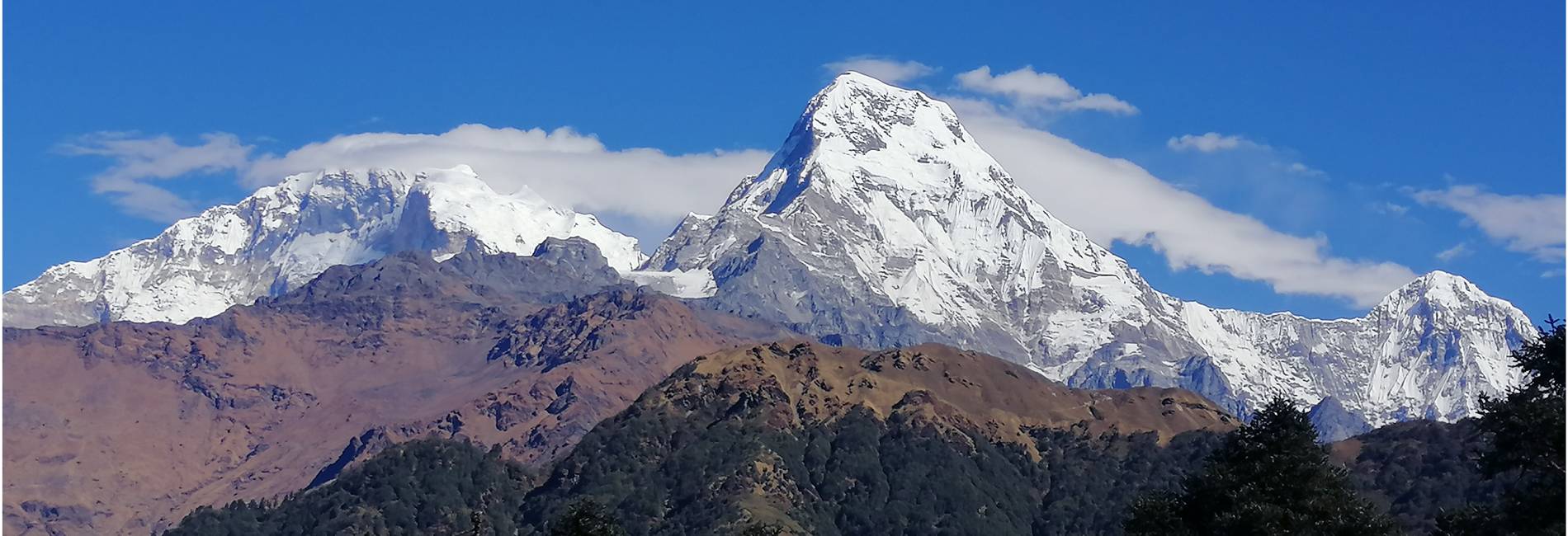
SHORT ANNAPURNA TREK
The Ghorepani Poon Hill Trek, also known as the Annapurna trek or Annapurna C trek, is a captivating journey through the Annapurna region of Nepal, renowned for its natural beauty and cultural richnes...
Any Questions? Let Us Know.
Recent Posts
17th June, 2025


















